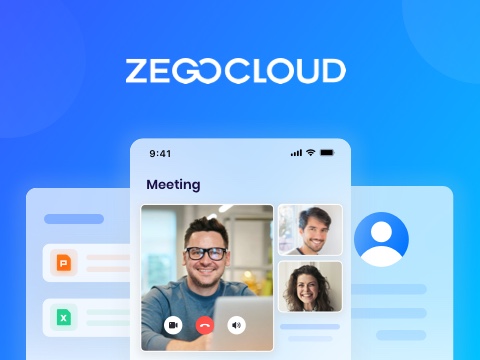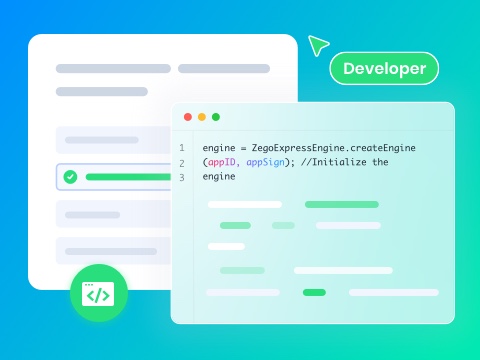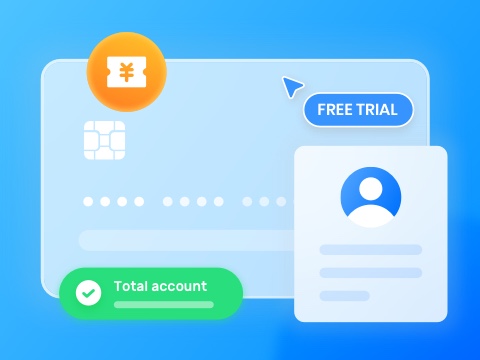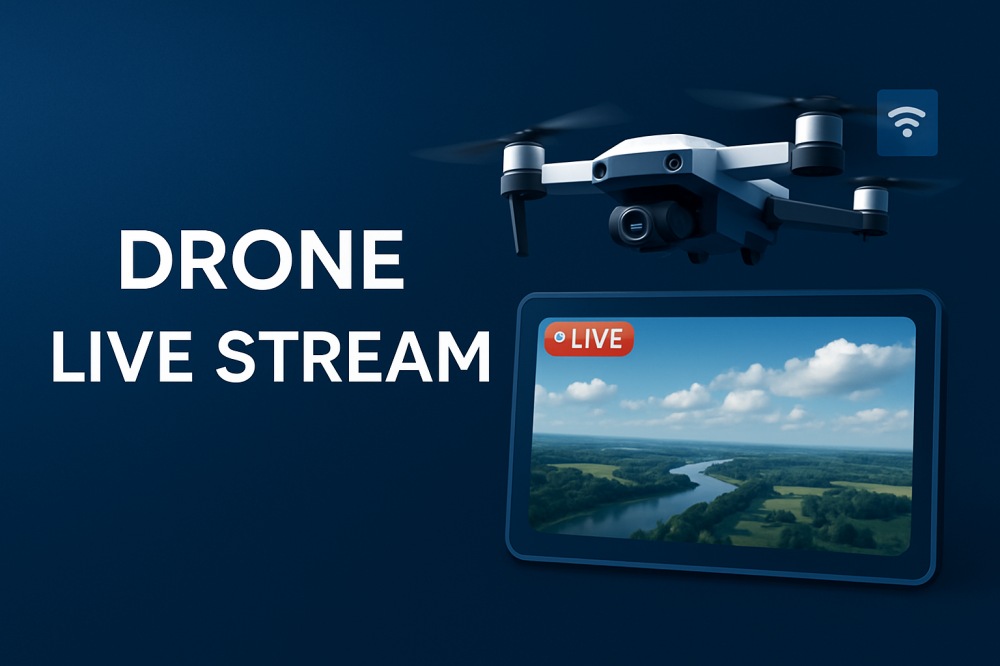Drones have transformed how people capture and share experiences as they bring a new perspective to live events. From landscapes to high-speed sports, drone live stream provides real-time entertainment like never before. Hence, this guide explores techniques and tips that would enable you to easily record and broadcast quality footage.
What is Drone Live Streaming?
Drone live streaming broadcasts the camera view of a drone and audio to an online viewer in real-time. Thus, the audience can see what is happening through a bird’s eyes. As the drone shows a live stream, it uses its camera and a wireless transmitter to send footage through Wi-Fi, cellular networks, or other connections to platforms like YouTube Live or Facebook Live.
Regarding working, the drone takes the video using its camera, and then there is a transmission system transmitting the video via a wireless connection. Besides, RTMP and WebRTC streaming protocols are used to provide smooth video. In addition, the operators manage the broadcast using the drone application or a computer and change the settings, including resolution and quality.
Why is Drone Video Becoming So Popular?
Many creators don’t know that drone live streaming is becoming a powerful way to capture unique perspectives. Hence, this section will highlight the reasons for its popularity to create high-quality content that stands out online:
- Exceptional Angles and Viewpoints: These devices provide aerial perspectives and angles that cannot be accessed by ground cameras. Thus, moviemakers and designers will be able to display scenery and phenomena with aerial shots to make videos deeper, dramatic, and unforgettable.
- Greater Accessibility and Affordability: Moreover, there are numerous low-end drone models that offer ease of use. Previously, aerial shots were only made possible by very expensive helicopters and plane-based arrangements. Now, anyone can make a high-quality recording at an inexpensive cost.
- Enhanced Marketing and Business Value: Businesses can now use drones for marketing, product videos, and tours/events. Thus, such videos attract attention on social media and ads to boost audience engagement. They work well on platforms like YouTube, Instagram, and TV.
- Safety and Versatility in Applications: When you want to capture dangerous places like mountains or cliffs, drones offer a unique perspective and easy access. Additionally, you can easily make surveys, journalism, and emergency work-based videos while ensuring human safety.
- Smoother, Higher-Quality Video Production: Modern drones deliver stable, sharp, and smooth video, and high frame rates and intelligent flight controls give professional results. Hence, creators can capture and edit footage easily to achieve high-quality effects.
User Cases of Drone Live Streaming
If you have decided to invest in the best drone for live streaming, you might question where and how to use/share those streams. Therefore, review this section and get to know 5 ideal use cases of such live streams to boost the audience engagement:
1. Emergency Response and Public Safety
The RPA allows first responders and police to see what is happening on the ground in case of an emergency by streaming aerial videos to them. Therefore, these videos can be used to oversee search and rescue missions or crowd management in major events.
Example: During wildfires in California, drones gave real-time visuals to help direct firefighting teams. They also monitored fire spread and hotspots and allowed crews to focus resources where they were needed most.
2. Live Event Coverage
Drone live video streaming also creates immersive coverage for concerts, sports matches, festivals, and public gatherings. Hence, fans enjoy unique aerial perspectives that make events more engaging and visually dynamic.
Example
- They are used at the Super Bowl to capture stadium-wide views and highlight player movement from above.
- Music festivals like Coachella use drones to provide live bird’s-eye views for online audiences.
3. News and Journalism
These streams are also used by journalists when they are reporting on breaking news, protests, and places that are inaccessible. Therefore, RPA provides live images that provide the audience with real-time information. This enables the media houses to air such facts and dramatic videos without putting the lives of journalists at risk.
Example: It has been used in 2022 in the conflict in Ukraine, where journalists recorded live footage of the frontline regions and destroyed infrastructure using RPA. Thus, this allowed news media companies to air live images from areas that were too dangerous to cover on the ground.
4. Industrial Inspection and Monitoring
Organizations also prefer drone video streaming as the first option when inspecting infrastructure such as wind turbines, oil rigs, and large agricultural farms. Therefore, construction managers will be able to view live feeds of the current projects and schedule repairs immediately. Simultaneously, it provides transparency and compliance with safety and documentation to refer to in the future.
Example: In 2023, a major wind farm in Texas used drones to inspect turbines for blade damage and mechanical issues. Thus, live aerial video enabled engineers to quickly identify problems and coordinate repairs without climbing the towers.
5. Tourism and Travel Marketing
Tourism boards, resorts, and travel agencies use drones to stream live aerial tours of scenic spots and events to attract visitors. Also, live interaction during these streams, such as Q&A sessions or guided virtual tours, lets audiences ask questions and explore locations. Additionally, resorts can showcase beaches, pools, and event venues in real time to encourage bookings.
Example: In 2022, the Maldives Tourism Board used drones to stream live aerial tours of luxury resorts and beaches. Viewers could see the islands’ clear waters, overwater villas, and surrounding coral reefs in real time.
How Does Drone Live Streaming Work?
When creators are new to drone live stream, they wonder how it works to deliver a different perspective from an aerial view. So, adhere to the sequential details and know how this type of stream works:
- Video Capture and Encoding: The drone camera captures video during flight and then transmits it to the controller or base station, which decodes it into a digital stream. Moreover, common protocols such as RTMP, RTP, or WebRTC are useful for transmitting video with low delay.
- Wireless Transmission: The drone transmits the coded video via Wi-Fi, 4G/5G networks, or specialized radio links. Furthermore, all the drones have embedded encoders, or some require external equipment or software, connected either through HDMI or USB.
- Transfer to Online Platforms: The next step is the transfer of the video to online platforms, such as YouTube Live, Facebook Live, or personal servers, with the help of the drone app or software. Hence, operators can adjust resolution, bitrate, and other settings before starting the live broadcast.
- Viewing in Real-Time: When the outcome is ready and delivered, viewers can watch the live video on any device. Besides, they can enjoy high-definition visuals and aerial perspectives with zero distractions.
- Security and Advanced Features: Additionally, for sensitive operations, streams can go through encrypted networks for secure viewing. Advanced setups offer instant playback, AI-based analysis, and cloud or local storage for later use.
How to Build a Drone Live Streaming System with ZEGOCLOUD
Suppose you want to build a reliable drone live streaming workflow with low latency and stable performance. In that case, ZEGOCLOUD’s RTC SDK provides a complete solution that is easy to integrate and works across platforms. It enables developers to stream high-quality drone footage in real-time, even in challenging network environments.
1. Fast and Simple Integration
With ZEGOCLOUD, developers can start pushing drone video streams with just a few lines of code. The live streaming SDK includes full weak-network optimization, which keeps the video stable even in areas with poor connectivity. This is especially important for drones operating in remote or complex locations.
2. Support for Private Deployment
For industries that handle sensitive information, such as public safety, government, military, and finance, ZEGOCLOUD supports private deployment. This allows the entire streaming system to run inside a local data center or a dedicated cloud environment. It helps organizations maintain full data control and meet strict compliance requirements.
3. Real-Time Interaction
ZEGOCLOUD supports real-time communication features such as text chat and voice interaction. This allows drone footage to be combined with live commentary or two-way communication, creating interactive workflows suitable for remote inspections, emergency response, agriculture monitoring, and site coordination.
4. Suitable for Multiple Industry Scenarios
ZEGOCLOUD enables drones to send real-time video and data back to a command center with minimal delay. Teams can monitor operations, analyze situations, and make decisions instantly. This improves efficiency and enhances safety in agriculture, construction, logistics, and public safety scenarios.
Conclusion
To wrap up, if you want to know about drone live stream, this guide has explained all the basics. So, review the article and learn why it’s famous, how it works, and where you can use these streams. Moreover, if you seek to implement real-time communication features for drone live streams, ZEGOCLOUD is a recommended choice.
FAQ
Q1. How can I reduce latency in drone live streaming?
Use ZEGOCLOUD’s RTC SDK. It provides real-time transmission with ultra-low latency and adaptive network optimization.
Q2. Can I stream from a drone directly to my app?
Yes. You can push the drone’s video feed directly into your web, mobile, or desktop app using the RTC SDK.
Q3. Can drone streams be recorded?
Yes. ZEGOCLOUD supports cloud and local recording for later playback or analysis.
Let’s Build APP Together
Start building with real-time video, voice & chat SDK for apps today!










